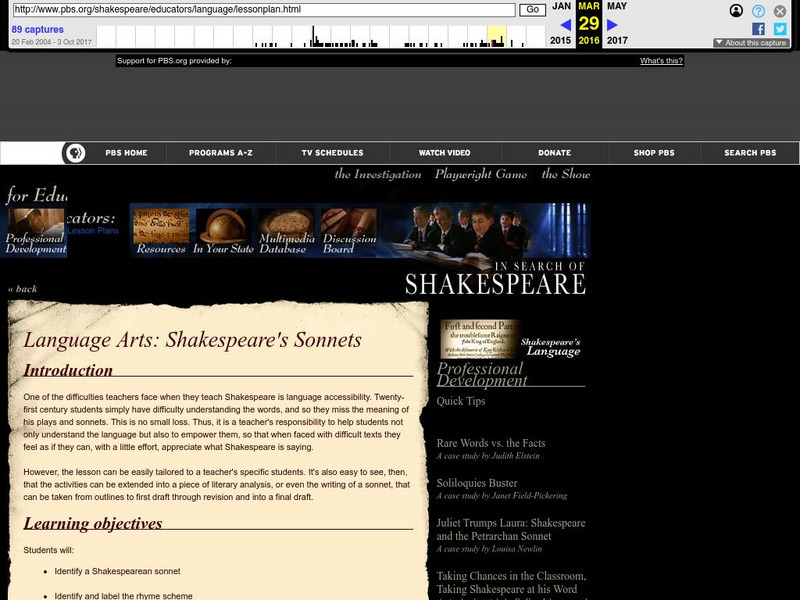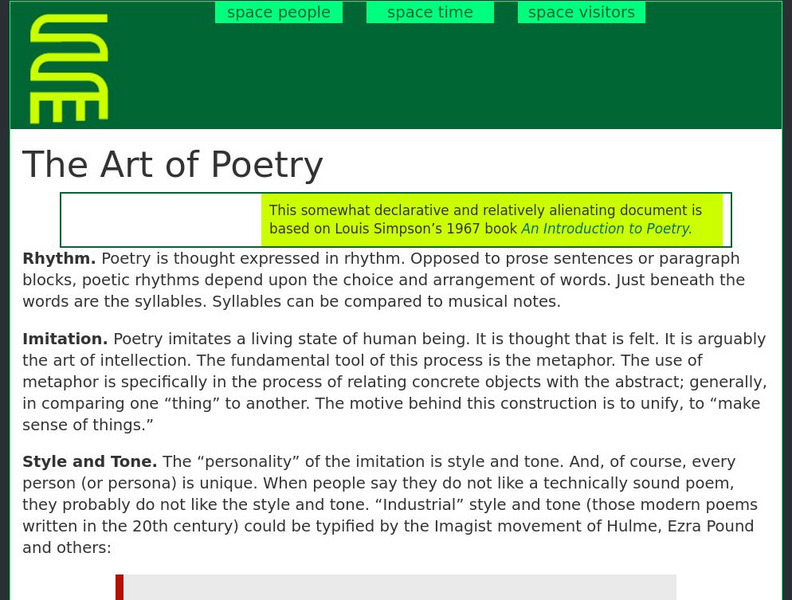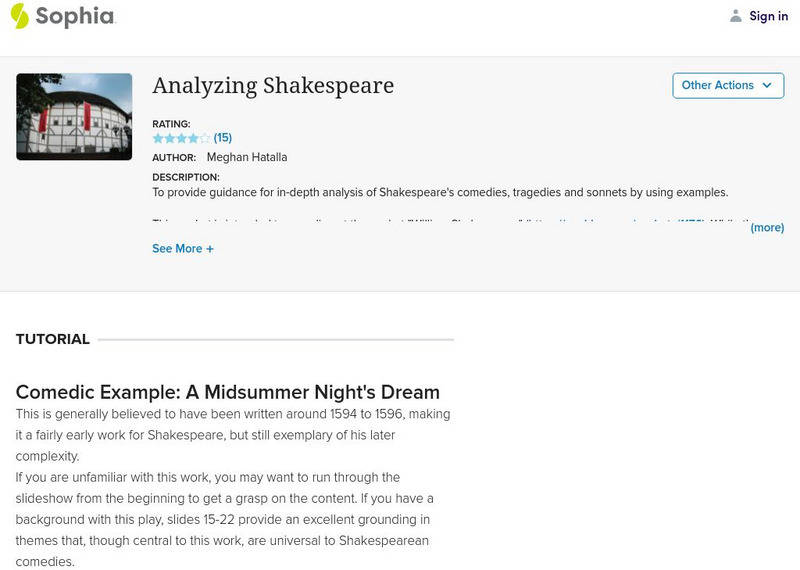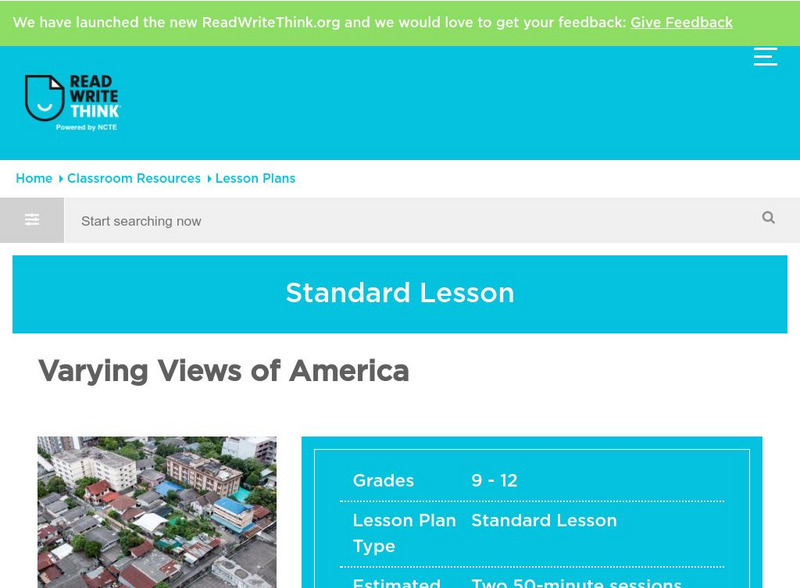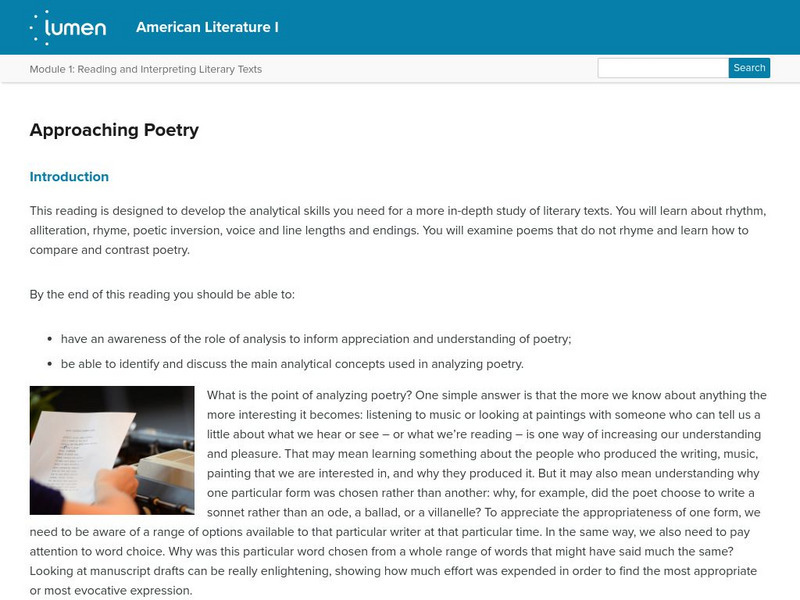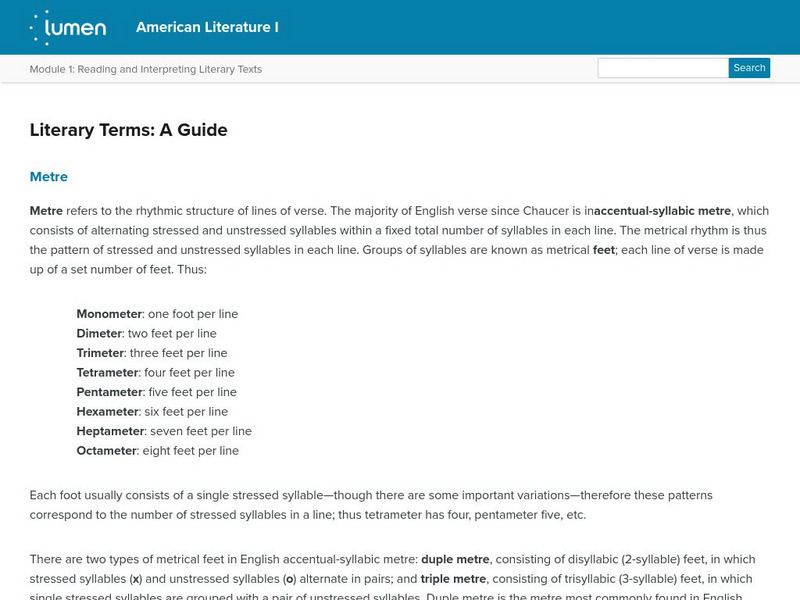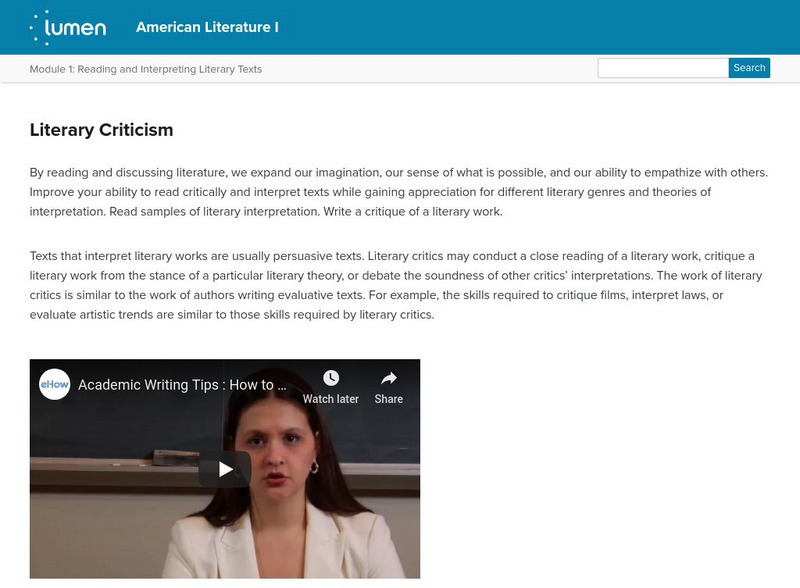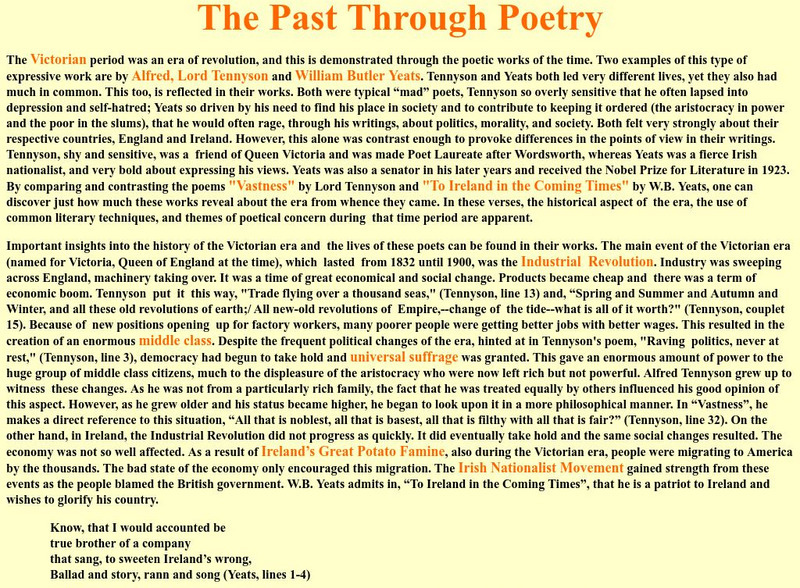University of Victoria (Canada)
The U Vic Writer's Guide: Literary Term: Drama
The University of Victoria's English department gives a comprehensive definition of "drama" in writing.
PBS
Pbs: Language Arts: Lesson Plans: Language Arts: Shakespeare's Sonnets
The purpose of this lesson is to help students cope with unfamiliar language in Shakespeare's sonnets and to help them understand and appreciate both what he says and how he says it.
National Endowment for the Humanities
Neh: Edsit Ement: Lesson 3: Navigating Modernism With J. Alfred Prufrock
In this lesson plan, students will consider Lesson 3: Navigating Modernism with J. Alfred Prufrock. Worksheets and other supporting materials can be found under the Resources tab.
Other
Poetry Analysis for 10th Grade Language Arts
Choose from the poems, then complete the reading, discussion, and writing activities. A good wrap-up to a poetry unit.
TES Global
Blendspace: 8th Grade Poetry Unit
This thirty-three-part learning module provides a poetry unit designed for 8th graders. This blendspace provides videos, web resources, and reference sheets related to the study of eighth grade poetry content.
Goshen College
Goshen College: Literary Analysis Guide
This resource not only explains how to analyze a text, but also, provides student examples of literary texts. W.9-10.9b Research/Argum, RI.11-12.5 Evaluate text structure
Academy of American Poets
Poets.org: William Shakespeare
This brief biographical overview of William Shakespeare includes information on his life and links to selected poems and sonnets. Includes a bibliography of selected works.
Other
Kintespace: The Art of Poetry
This site is an analysis of rhythm, imitation, style, tone, and technique of poetry. References to imagists and their works are also included
Other
William Shakespeare Info: William Shakespeare: The Complete Works
Although the lay-out of this page is not particularly easy on the eye, the content will prove valuable to teachers and children alike. In addition to a brisk overview of his life and work, there are links to more detailed information on...
Sophia Learning
Sophia: Selecting Topics for Literary Analysis
A series of three PDF documents providing definitions of commonly used terms when preparing to write a literary analysis, explaining how to comment on a literary text, and demonstrating the process of analyzing the literary text "Hills...
Sophia Learning
Sophia: Analyzing Shakespeare
Learn to analyze Shakespearean comedies, tragedies, and sonnets. First use examples provided in a slideshow of A Midsummer Night's Dream to understand the process and topics included in an analysis of a comedy. Then learn to use three...
University of Virginia
University of Virginia: Noh Plays
This is a very comprehensive resource that includes discussion of Japanese Noh plays as well as the texts for thirteen plays. The texts are available in both Japanese and English. RL.9-10.10a&b text complexity, RL.11-12.7 Multi...
ReadWriteThink
Read Write Think: Poetry: Varying Views of America
Lesson allows young scholars to examine the various views of American perspective through studying three poems by diverse poets: "I Hear America Singing" by Walt Whitman, "I, Too, Sing America" by Langston Hughes, and "On the Pulse of...
Annenberg Foundation
Annenberg Learner: Literary Visions
A series of 24 instructional videos, each about 30 minutes in length, designed to teach literary analysis. Topics include Responding to Literature, The Elements of Short Fiction, Tone and Style in Short fiction, The Elements of Poetry,...
E Reading Worksheets
E Reading Worksheets: Figurative Language: Shakespeare
This learning module provides remediation and extra practice with identifying figurative language techniques found in excerpts written by William Shakespeare. A worksheet is available to help reinforce the concept of figurative language...
Lumen Learning
Lumen: Reading and Interpreting Literary Texts: Approaching Poetry
This lesson focuses on the how to approach the analysis of poetry. It provides a series of student activities such as having students read and compare a draft and the final version of William Blake's "Tyger" which is followed by a...
Lumen Learning
Lumen: Reading and Interpreting Literary Texts: Literary Terms: A Guide
This is a guide to poetic literary terms such as meter and an explanation of several types of meter, types of stanzas, types of rhyme, etc.
Lumen Learning
Lumen: Reading and Interpreting Literary Texts: Literary Criticism
This lesson focuses on how to write a literary criticism, the different theories and approaches to literary criticism, and their standard format.
Other
The Wondering Minstrels
The Wondering Minstrels website provides a poem a day, complete with analysis, criticism, biographical information, literary anecdotes, trivia, and our own skewed sense of humor. RL.9-10.10a&b text complexity, RL.11-12.10a/b Text...
Other
California Polytechnic State University: Shakespearean Verse and Prose
Explains terms used in discussing how verse and prose were used by Shakespeare, and how to recognize prose, rhyme, and blank verse in his plays, and what their functions are. RL.9-10.5 text structure effects
Other
Chateauguay Valley Regional High School: The Past Through Poetry by Mary Sully
This is a good example of how to write a literary analysis essay on poetry. This example compares and contrasts Tennyson and Yeats, Victorian poets, on the basis of their lives and their poetry. W.9-10.9a Analysis
TED Talks
Ted: Ted Ed: Insults by Shakespeare
The viewer is given a closer look into Shakespeare's insults and his wit. [6:24] RL.11-12.7 Multi Interpretations
CK-12 Foundation
Ck 12: 6.1 Writing About Literature: Analyzing Prose
[Free Registration/Login may be required to access all resource tools.] Learn to analyze prose by understanding connotation and denotation, identifying metaphors and similes, looking for repetition, and finding imagery in a text.
Blackdog Media
Classic Reader: Author: William Shakespeare
This site features the author William Shakespeare including a biography and the full text of 39 of his famous plays. RL.9-10.10a&b text complexity, RL.11-12.10a/b Text Complexity



